Mn(II) Sorption on Stream Sediments Sampled in Manganese Mining Area: Dynamics and Mechanisms
Abstract
:1. Introduction
2. Materials and Methods
2.1. Sampling and Storage
2.2. Experimental Methods
2.2.1. Comparison of Mn(II) Sorption Properties in Soils
2.2.2. Analysis of Influencing Factors on DX Sorption Performance
2.2.3. Repeated Sorption
2.2.4. Microbial Activity Analysis
2.3. Analytical Methods
2.3.1. Basic Physical and Chemical Properties of Soil
2.3.2. Heavy Metal Content and Morphological
2.3.3. DNA Extraction and High-Throughput Sequencing Analysis
2.4. Sorption Models
2.4.1. Sorption Kinetic Models
2.4.2. Sorption Thermodynamic Models
2.5. Statistical Analysis
3. Results and Discussions
3.1. Analysis of Physicochemical Properties in DX Sediments
3.2. Effect of Operating Variables
3.2.1. Sorption Performance and Equilibrium Time
3.2.2. Effect of Initial Manganese Concentration in Solution on Mn(II) Sorption
3.2.3. Effect of Temperature and Sediment Solid-Liquid Ratio on Mn(II) Sorption
3.2.4. Effect of pH on Mn(II) Sorption
3.2.5. Effect of Coexisting Cations on Mn(II) Sorption
3.2.6. Repeated Sorption
3.3. Exploring the Mechanism of Manganese Sorption Using DX
3.3.1. Sorption Kinetic Model
3.3.2. Isothermal Sorption Model
3.4. Effect of NaN3 on Microbial Activity
3.5. Analysis of Changes in Chemical Forms for Heavy Metals
4. Conclusions and Perspectives
- (1)
- The sorption capacity of Mn(II) differs greatly among different soil sample types. When the sediment dosage was 10 g·L−1, DX has a good effect on Mn(II) removal and the final removal rate up to 84.85%. Its sorption performance was much higher than that of LB and XY.
- (2)
- The sorption process follows the Elovich model (R2 = 0.994) and Freundlich model (R2 = 0.936–0.984). The sorption process is mainly based on multi-molecular layer chemisorption, which is jointly influenced by the adsorbent and adsorbent mass.
- (3)
- Environmental factors had a significant effect on the Mn(II) sorption process. In a certain range, the increase of temperature, sediment dosage(4–12 g·L−1) and pH were favorable to promote the sorption of Mn(II) by the sediment DX.
- (4)
- After five repetitions of sorption, the sorption sites of DX reached basic saturation when the sediment dosage was 10 g·L−1. Meanwhile, in mixed heavy metal solutions, the presence of Pb2+, Zn2+, Cu2+ and Fe2+ coexisting cations all inhibited the sorption of Mn(II), especially Zn2+.
- (5)
- Microorganisms played a key role in the process of heavy metal sorption and Fe–Mn oxide generation. The addition of NaN3 inhibited the activity of microorganisms in the soil, and the content of exchangeable and carbonate-bound manganese increased, while the content of Fe–Mn bound state decreased.
Supplementary Materials
Author Contributions
Funding
Institutional Review Board Statement
Informed Consent Statement
Data Availability Statement
Conflicts of Interest
References
- Duan, N.; Dan, Z.; Wang, F.; Pan, C.; Zhou, C.; Jiang, L. Electrolytic manganese metal industry experience based China’s new model for cleaner production promotion. J. Clean. Prod. 2011, 19, 2082–2087. [Google Scholar] [CrossRef]
- Xu, F.; Jiang, L.; Dan, Z.; Gao, X.; Duan, N.; Han, G.; Zhu, H. Water balance analysis and wastewater recycling investigation in electrolytic manganese industry of China—A case study. Hydrometallurgy 2014, 149, 12–22. [Google Scholar] [CrossRef]
- Zhang, Y.; Liu, X.; Xu, Y.; Tang, B.; Wang, Y.; Mukiza, E. Preparation and characterization of cement treated road base material utilizing electrolytic manganese residue. J. Clean. Prod. 2019, 232, 980–992. [Google Scholar] [CrossRef]
- Shu, J.; Liu, R.; Liu, Z.; Qiu, J.; Chen, H.; Tao, C. Simultaneous removal of ammonia nitrogen and manganese from wastewater using nitrite by electrochemical method. Environ. Technol. 2017, 38, 370–376. [Google Scholar] [CrossRef]
- Ma, Y.; Zheng, X.; Fang, Y.; Xu, K.; Zhao, M. Autotrophic denitrification in constructed wetlands: Achievements and challenges. Bioresour. Technol. 2020, 318, 123778. [Google Scholar] [CrossRef]
- Shu, J.; Liu, R.; Liu, Z.; Du, J.; Tao, C. Manganese recovery and ammonia nitrogen removal from simulation wastewater by pulse electrolysis. Sep. Purif. Technol. 2016, 168, 107–113. [Google Scholar] [CrossRef]
- Yu, C.; Mei, Y.; Xue, Y.; Wu, C.; Ye, H.; Li, J.; Du, D. A novel approach for recovery of manganese from on-site manganese-bearing wastewater. J. Clean. Prod. 2019, 227, 675–682. [Google Scholar] [CrossRef]
- Yu, W.; Polgári, M.; Gyollai, I.; Fintor, K.; Huang, H.; Szabó, M.; Du, Y. Microbial metallogenesis of early carboniferous manganese deposit in central Guangxi, South China. Ore Geol. Rev. 2021, 136, 104251. [Google Scholar] [CrossRef]
- Liu, K.; Fan, L.; Li, Y.; Zhou, Z.; Chen, C.; Chen, B.; Yu, F. Concentrations and health risks of heavy metals in soils and crops around the Pingle manganese (Mn) mine area in Guangxi Province, China. Environ. Sci. Pollut. R. 2018, 25, 30180–30190. [Google Scholar] [CrossRef]
- Shu, J.; Lin, F.; Chen, M.; Li, B.; Wei, L.; Wang, J.; Luo, Z.; Wang, R. An innovative method to enhance manganese and ammonia nitrogen leaching from electrolytic manganese residue by surfactant and anode iron plate. Hydrometallurgy 2020, 193, 105311. [Google Scholar] [CrossRef]
- Parde, D.; Patwa, A.; Shukla, A.; Vijay, R.; Killedar, D.J.; Kumar, R. A review of constructed wetland on type, treatment and technology of wastewater. Environ. Technol. Innov. 2021, 21, 101261. [Google Scholar] [CrossRef]
- Nuamah, L.A.; Li, Y.; Pu, Y.; Nwankwegu, A.S.; Haikuo, Z.; Norgbey, E.; Banahene, P.; Bofah-Buoh, R. Constructed wetlands, status, progress, and challenges. The need for critical operational reassessment for a cleaner productive ecosystem. J. Clean. Prod. 2020, 269, 122340. [Google Scholar] [CrossRef]
- Tao, W. Microbial removal and plant uptake of nitrogen in constructed wetlands: Mesocosm tests on influencing factors. Environ. Sci. Pollut. R. 2018, 25, 36425–36437. [Google Scholar] [CrossRef] [PubMed]
- Yang, Y.; Zhao, Y.; Liu, R.; Morgan, D. Global development of various emerged substrates utilized in constructed wetlands. Bioresour. Technol. 2018, 261, 441–452. [Google Scholar] [CrossRef]
- Wang, Y.; Cai, Z.; Sheng, S.; Pan, F.; Chen, F.; Fu, J. Comprehensive evaluation of substrate materials for contaminants removal in constructed wetlands. Sci. Total Environ. 2020, 701, 134736. [Google Scholar] [CrossRef]
- Wang, D.; Lin, H.; Ma, Q.; Bai, Y.; Qu, J. Manganese oxides in Phragmites rhizosphere accelerates ammonia oxidation in constructed wetlands. Water Res. 2021, 205, 117688. [Google Scholar] [CrossRef]
- Liu, H.; Hu, Z.; Zhang, Y.; Zhang, J.; Xie, H.; Liang, S. Microbial nitrogen removal of ammonia wastewater in poly (butylenes succinate)-based constructed wetland: Effect of dissolved oxygen. Appl. Microbiol. Biot. 2018, 102, 9389–9398. [Google Scholar] [CrossRef]
- Chen, P.; Culbreth, M.; Aschner, M. Exposure, epidemiology, and mechanism of the environmental toxicant manganese. Environ. Sci. Pollut. R. 2016, 23, 13802–13810. [Google Scholar] [CrossRef]
- Wang, Y.N.; Tsang, Y.F.; Wang, H.; Sun, Y.; Song, Y.; Pan, X.; Luo, S. Effective stabilization of arsenic in contaminated soils with biogenic manganese oxide (BMO) materials. Environ. Pollut. 2020, 258, 113481. [Google Scholar] [CrossRef]
- Zhang, L.; Wang, J.; Qiao, H.; Liu, F.; Fu, Z. Synthesis of manganese oxides for adsorptive removal of ammonia nitrogen from aqueous solutions. J. Clean. Prod. 2020, 272, 123055. [Google Scholar] [CrossRef]
- Bai, Y.; Su, J.; Wen, Q.; Huang, T.; Chang, Q.; Ali, A. Characterization and mechanism of Mn(II)-based mixotrophic denitrifying bacterium (Cupriavidus sp. HY129) in remediation of nitrate (NO3−-N) and manganese (Mn(II)) contaminated groundwater. J. Hazard. Mater. 2021, 408, 124414. [Google Scholar] [CrossRef] [PubMed]
- Tang, W.; Gong, J.; Wu, L.; Li, Y.; Zhang, M.; Zeng, X. DGGE diversity of manganese mine samples and isolation of a Lysinibacillus sp. efficient in removal of high Mn (II) concentrations. Chemosphere 2016, 165, 277–283. [Google Scholar] [CrossRef] [PubMed]
- Barrio-Parra, F.; Elío, J.; De Miguel, E.; García-González, J.E.; Izquierdo, M.; Álvarez, R. Environmental risk assessment of cobalt and manganese from industrial sources in an estuarine system. Environ. Geochem. Health 2018, 40, 737–748. [Google Scholar] [CrossRef]
- Li, R.; Gao, L.; Wu, Q.; Liang, Z.; Hou, L.; Yang, Z.; Chen, J.; Jiang, T.; Zhu, A.; Li, M. Release characteristics and mechanisms of sediment phosphorus in contaminated and uncontaminated rivers: A case study in South China. Environ. Pollut. 2021, 268, 115749. [Google Scholar] [CrossRef]
- Huang, Z.; Tang, Y.; Zhang, K.; Chen, Y.; Wang, Y.; Kong, L.; You, T.; Gu, Z. Environmental risk assessment of manganese and its associated heavy metals in a stream impacted by manganese mining in South China. Hum. Ecol. Risk Assess. 2016, 22, 1341–1358. [Google Scholar] [CrossRef]
- Jones, M.R.; Luther, G.W.; Mucci, A.; Tebo, B.M. Concentrations of reactive Mn(III)-L and MnO2 in estuarine and marine waters determined using spectrophotometry and the leuco base, leucoberbelin blue. Talanta 2019, 200, 91–99. [Google Scholar] [CrossRef]
- Tessier, A.; Campbell, P.G.C.; Bisson, M. Sequential extraction procedure for the speciation of particulate trace metals. Anal. Chem. 1979, 51, 844–851. [Google Scholar] [CrossRef]
- Nica, I.; Zaharia, C.; Suteu, D. Hydrogel Based on Tricarboxi-Cellulose and Poly (Vinyl Alcohol) Used as Biosorbent for Cobalt Ions Retention. Polymers 2021, 13, 1444. [Google Scholar] [CrossRef]
- Van Veenhuyzen, B.; Tichapondwa, S.; Hörstmann, C.; Chirwa, E.; Brink, H.G. High capacity Pb (II) adsorption characteristics onto raw-and chemically activated waste activated sludge. J. Hazard. Mater. 2021, 416, 125943. [Google Scholar] [CrossRef]
- Buyang, S.; Yi, Q.; Cui, H.; Wan, K.; Zhang, S. Distribution and adsorption of metals on different particle size fractions of sediments in a hydrodynamically disturbed canal. Sci. Total Environ. 2019, 670, 654–661. [Google Scholar] [CrossRef]
- Vázquez-Ortega, A.; Fein, J.B. Thermodynamic modeling of Mn (II) adsorption onto manganese oxidizing bacteria. Chem. Geol. 2017, 464, 147–154. [Google Scholar] [CrossRef]
- Piazza, A.; Ciancio Casalini, L.; Pacini, V.A.; Sanguinetti, G.; Ottado, J.; Gottig, N. Environmental bacteria involved in manganese (II) oxidation and removal from groundwater. Front. Microbiol. 2019, 10, 119. [Google Scholar] [CrossRef] [PubMed] [Green Version]
- Abatal, M.; Olguin, M.T.; Anastopoulos, I.; Giannakoudakis, D.A.; Lima, E.C.; Vargas, J.; Aguilar, C. Comparison of Heavy Metals Removal from Aqueous Solution by Moringa oleifera Leaves and Seeds. Coatings 2021, 11, 508. [Google Scholar] [CrossRef]
- Long, J.; Huang, X.; Fan, X.; Peng, Y.; Xia, J. Effective adsorption of nickel (II) with Ulva lactuca dried biomass: Isotherms, kinetics and mechanisms. Water Sci. Technol. 2018, 78, 156–164. [Google Scholar] [CrossRef] [PubMed]
- Fawzy, M.; Nasr, M.; Adel, S.; Nagy, H.; Helmi, S. Environmental approach and artificial intelligence for Ni(II) and Cd(II) biosorption from aqueous solution using Typha domingensis biomass. Ecol. Eng. 2016, 95, 743–752. [Google Scholar] [CrossRef]
- Serencam, H.; Ozdes, D.; Duran, C.; Tufekci, M. Biosorption properties of Morus alba L. for Cd (II) ions removal from aqueous solutions. Environ. Monit. Assess. 2013, 185, 6003–6011. [Google Scholar] [CrossRef]
- Tavlieva, M.P.; Genieva, S.D.; Georgieva, V.G.; Vlaev, L.T. Thermodynamics and kinetics of the removal of manganese(II) ions from aqueous solutions by white rice husk ash. J. Mol. Liq. 2015, 211, 938–947. [Google Scholar] [CrossRef]
- Xie, S.; Wen, Z.; Zhan, H.; Jin, M. An Experimental Study on the Adsorption and Desorption of Cu(II) in Silty Clay. Geofluids 2018, 2018, 3610921. [Google Scholar] [CrossRef]
- Iftekhar, S.; Ramasamy, D.L.; Srivastava, V.; Asif, M.B.; Sillanpää, M. Understanding the factors affecting the adsorption of Lanthanum using different adsorbents: A critical review. Chemosphere 2018, 204, 413–430. [Google Scholar] [CrossRef]
- Ibrahiem, H.A.; Dougdoug, W.E.; Hefni, H.H.H.; El-Sawy, A.A.; Kamal, H.; Mahmoud, K. Removal of Ni (II), Mn (II) and Zn (II) from crude yellow cake aqueous solution by cross-linked chitosan and polyvinyl alcohol. Egypt. J. Pet. 2021, 30, 61–69. [Google Scholar] [CrossRef]
- Nowruzi, R.; Heydari, M.; Javanbakht, V. Synthesis of a chitosan/polyvinyl alcohol/activate carbon biocomposite for removal of hexavalent chromium from aqueous solution. Int. J. Biol. Macromol. 2020, 147, 209–216. [Google Scholar] [CrossRef] [PubMed]
- Sareban, Z.; Javanbakht, V. Preparation and characterization of a novel nanocomposite of clinoptilolite/maghemite/chitosan/urea for manganese removal from aqueous solution. Korean J. Chem. Eng. 2017, 34, 2886–2900. [Google Scholar] [CrossRef]
- Idrees, M.; Batool, S.; Ullah, H.; Hussain, Q.; Al-Wabel, M.I.; Ahmad, M.; Hussain, A.; Riaz, M.; Ok, Y.S.; Kong, J. Adsorption and thermodynamic mechanisms of manganese removal from aqueous media by biowaste-derived biochars. J. Mol. Liq. 2018, 266, 373–380. [Google Scholar] [CrossRef]
- Campillo-Cora, C.; Conde-Cid, M.; Arias-Estévez, M.; Fernández-Calviño, D.; Alonso-Vega, F. Specific Adsorption of Heavy Metals in Soils: Individual and Competitive Experiments. Agronomy 2020, 10, 1113. [Google Scholar] [CrossRef]
- Muliwa, A.M.; Onyango, M.S.; Maity, A.; Ochieng, A. Remediation of manganese in mine impacted water by clay/manganese oxide hybrid adsorbent: Equilibrium, kinetics and thermodynamic studies. Int. J. Environ. Sci. Technol. 2019, 16, 1985–1998. [Google Scholar] [CrossRef]
- Rahman, M.S.; Clark, M.W.; Yee, L.H.; Burton, E.D. Arsenic(V) sorption kinetics in long-term arsenic pesticide contaminated soils. Appl. Geochem. 2019, 111, 104444. [Google Scholar] [CrossRef]
- Largitte, L.; Pasquier, R. A review of the kinetics adsorption models and their application to the adsorption of lead by an activated carbon. Chem. Eng. Res. Des. 2016, 109, 495–504. [Google Scholar] [CrossRef]
- Wang, C.; Boithias, L.; Ning, Z.; Han, Y.; Sauvage, S.; Sánchez-Pérez, J.; Kuramochi, K.; Hatano, R. Comparison of Langmuir and Freundlich adsorption equations within the SWAT-K model for assessing potassium environmental losses at basin scale. Agric. Water Manag. 2017, 180, 205–211. [Google Scholar] [CrossRef]
- Elbana, T.A.; Magdi Selim, H.; Akrami, N.; Newman, A.; Shaheen, S.M.; Rinklebe, J. Freundlich sorption parameters for cadmium, copper, nickel, lead, and zinc for different soils: Influence of kinetics. Geoderma 2018, 324, 80–88. [Google Scholar] [CrossRef]
- Hendrix, K.; Bleyen, N.; Mennecart, T.; Bruggeman, C.; Valcke, E. Sodium azide used as microbial inhibitor caused unwanted by-products in anaerobic geochemical studies. Appl. Geochem. 2019, 107, 120–130. [Google Scholar] [CrossRef]
- Cabrol, L.; Quéméneur, M.; Misson, B. Inhibitory effects of sodium azide on microbial growth in experimental resuspension of marine sediment. J. Microbiol. Meth. 2017, 133, 62–65. [Google Scholar] [CrossRef] [PubMed]
- Iram, S.; Shabbir, R.; Zafar, H.; Javaid, M. Biosorption and Bioaccumulation of Copper and Lead by Heavy Metal-Resistant Fungal Isolates. Arab. J. Sci. Eng. 2015, 40, 1867–1873. [Google Scholar] [CrossRef]
- Nafiu, A.; Aliyu, A.A.; Aisha, A. Heavy metals and soil microbes. Environ. Chem. Lett. 2017, 15, 65–84. [Google Scholar] [CrossRef]
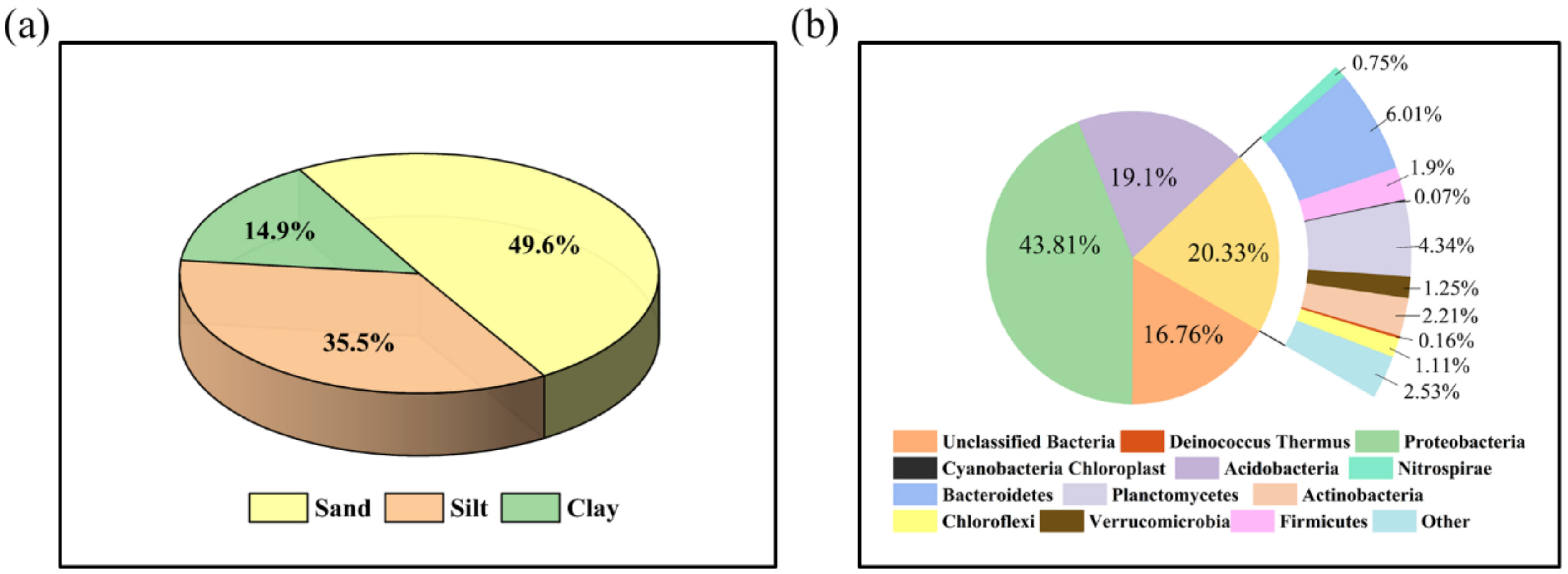
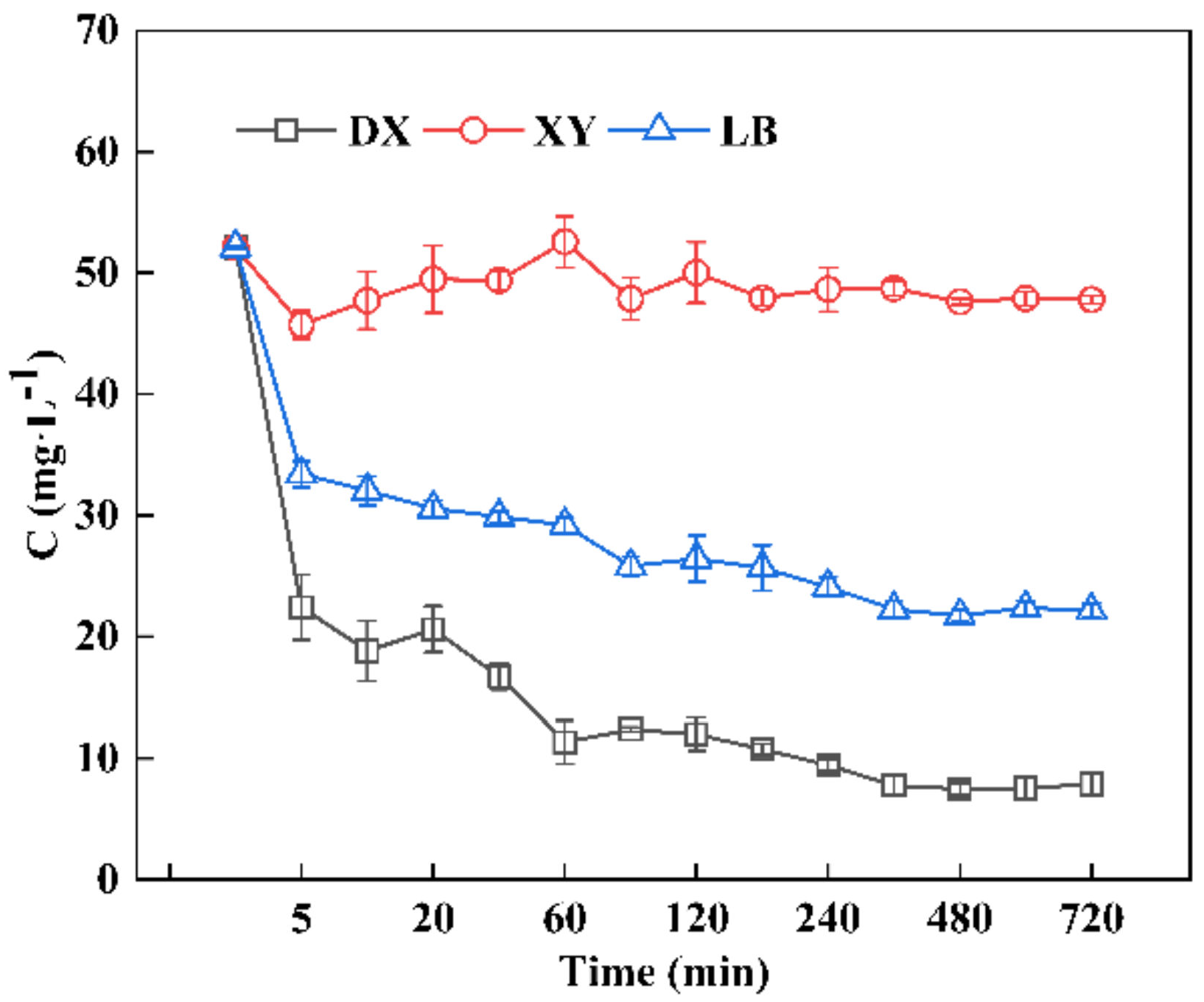

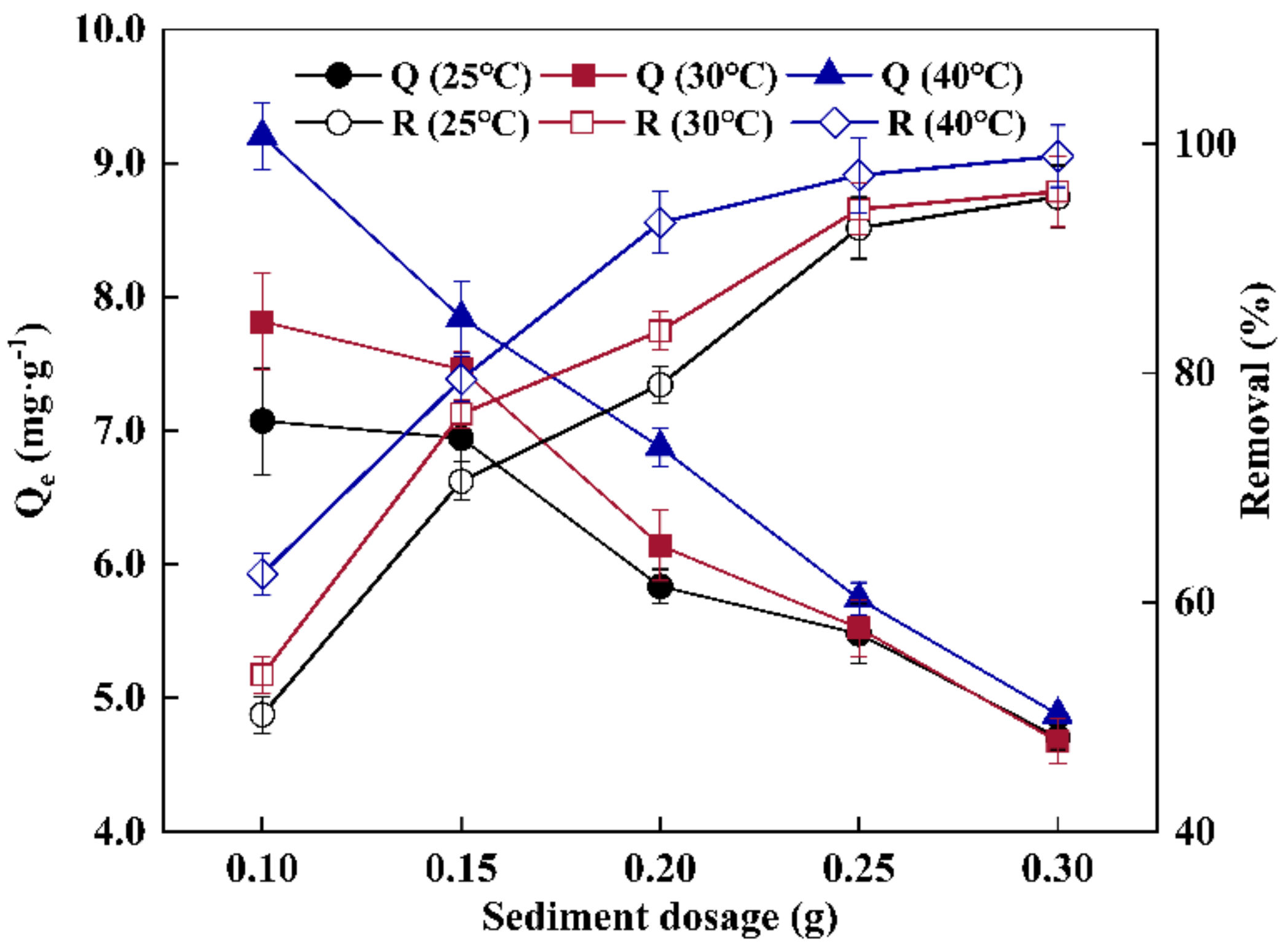
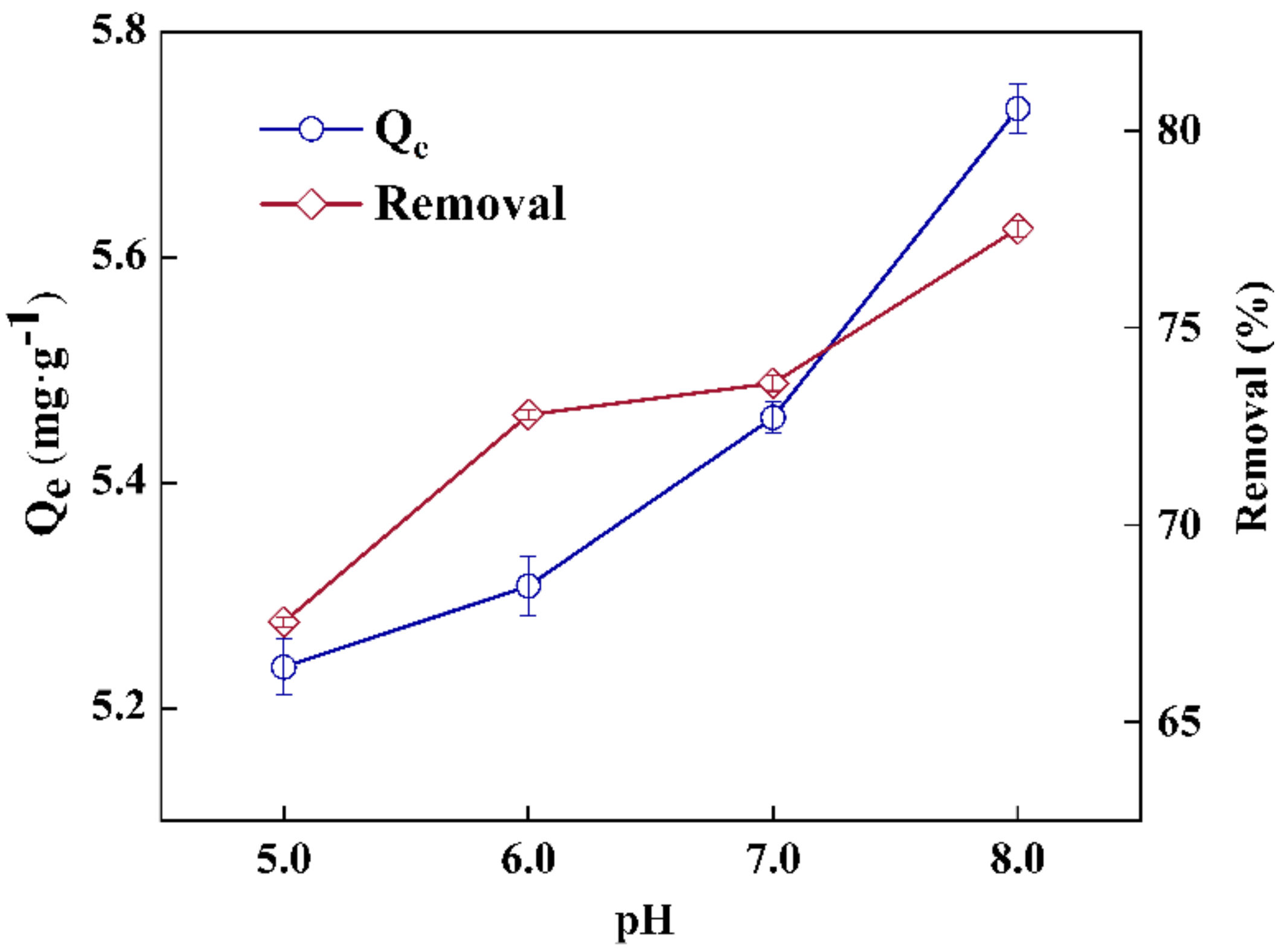

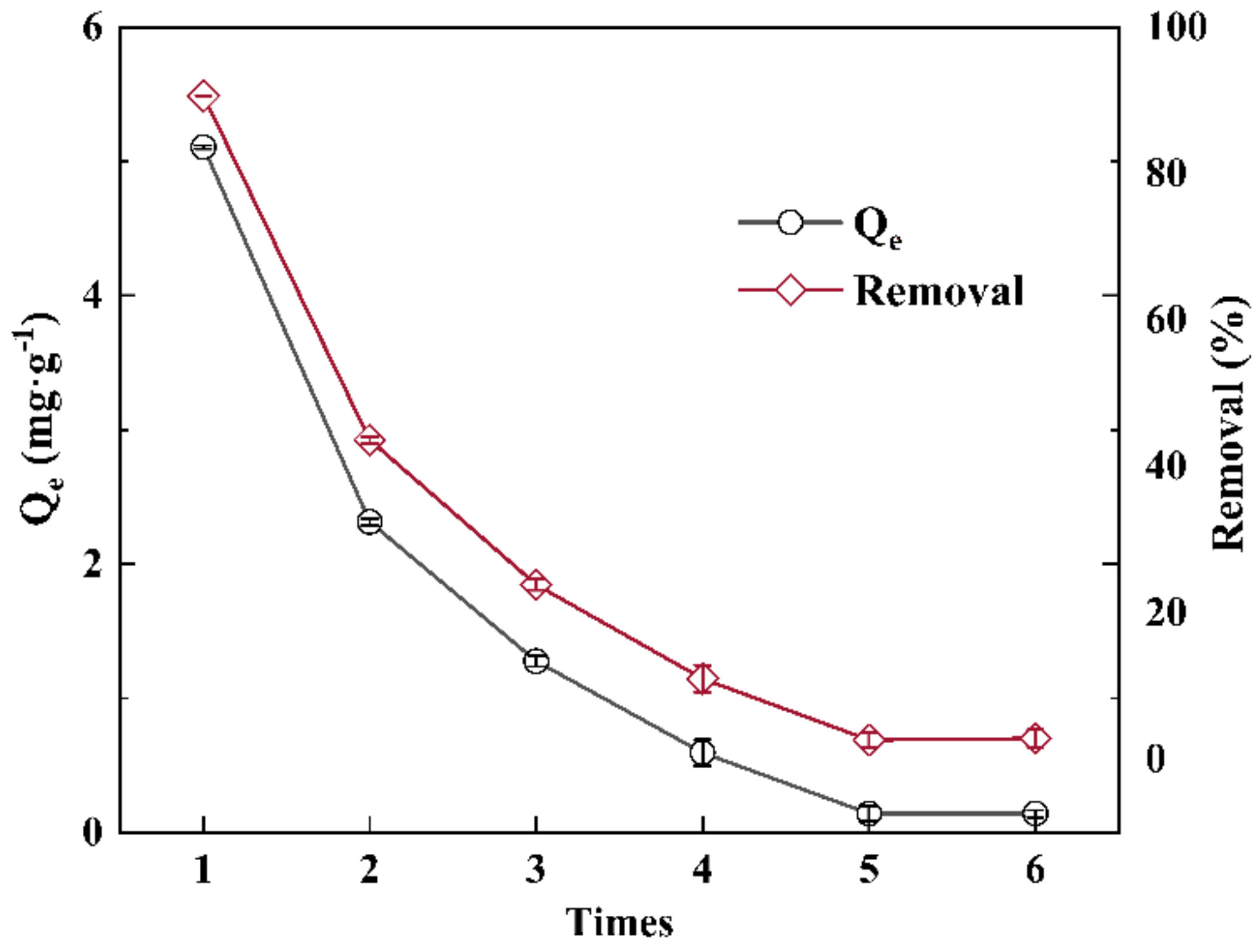
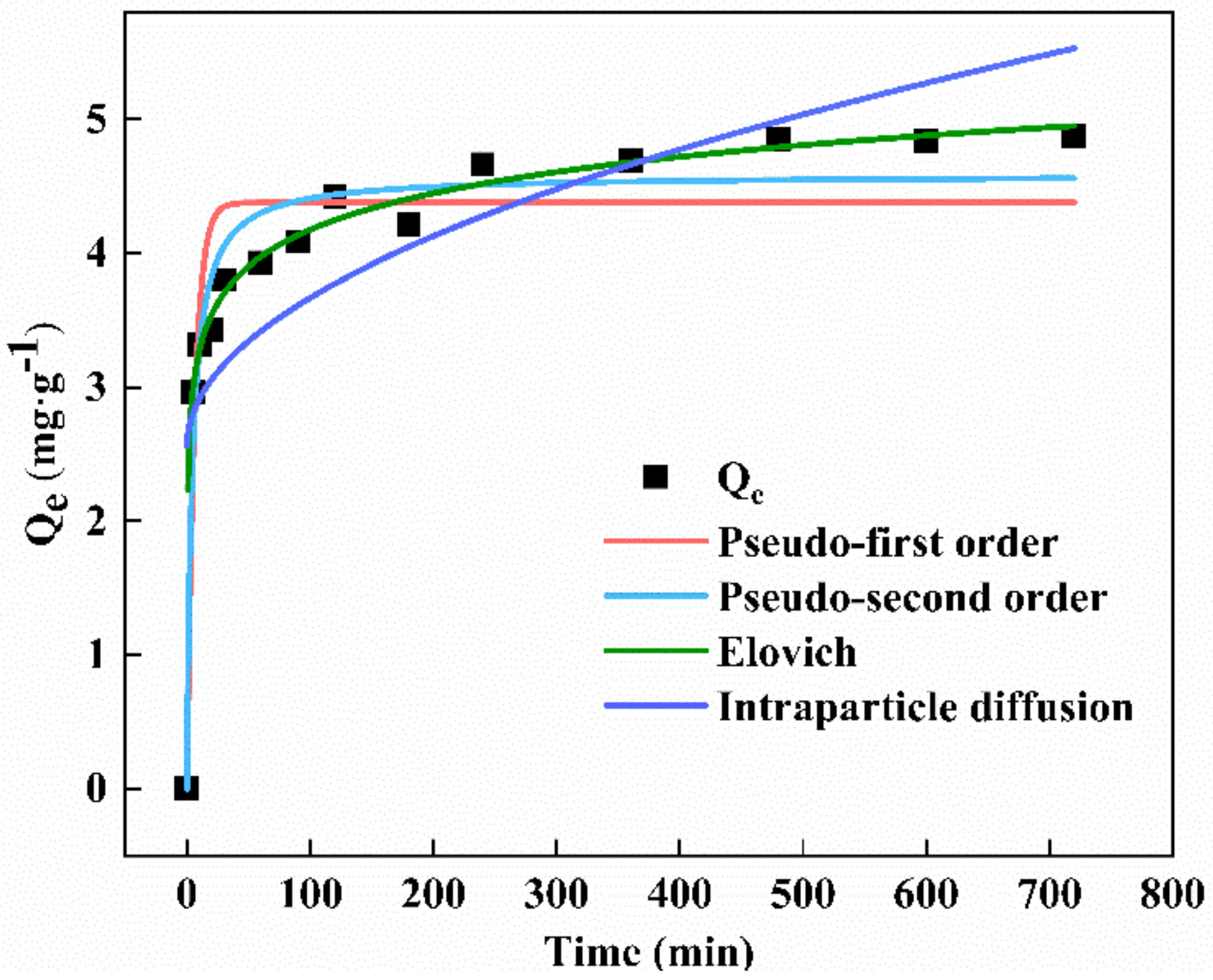
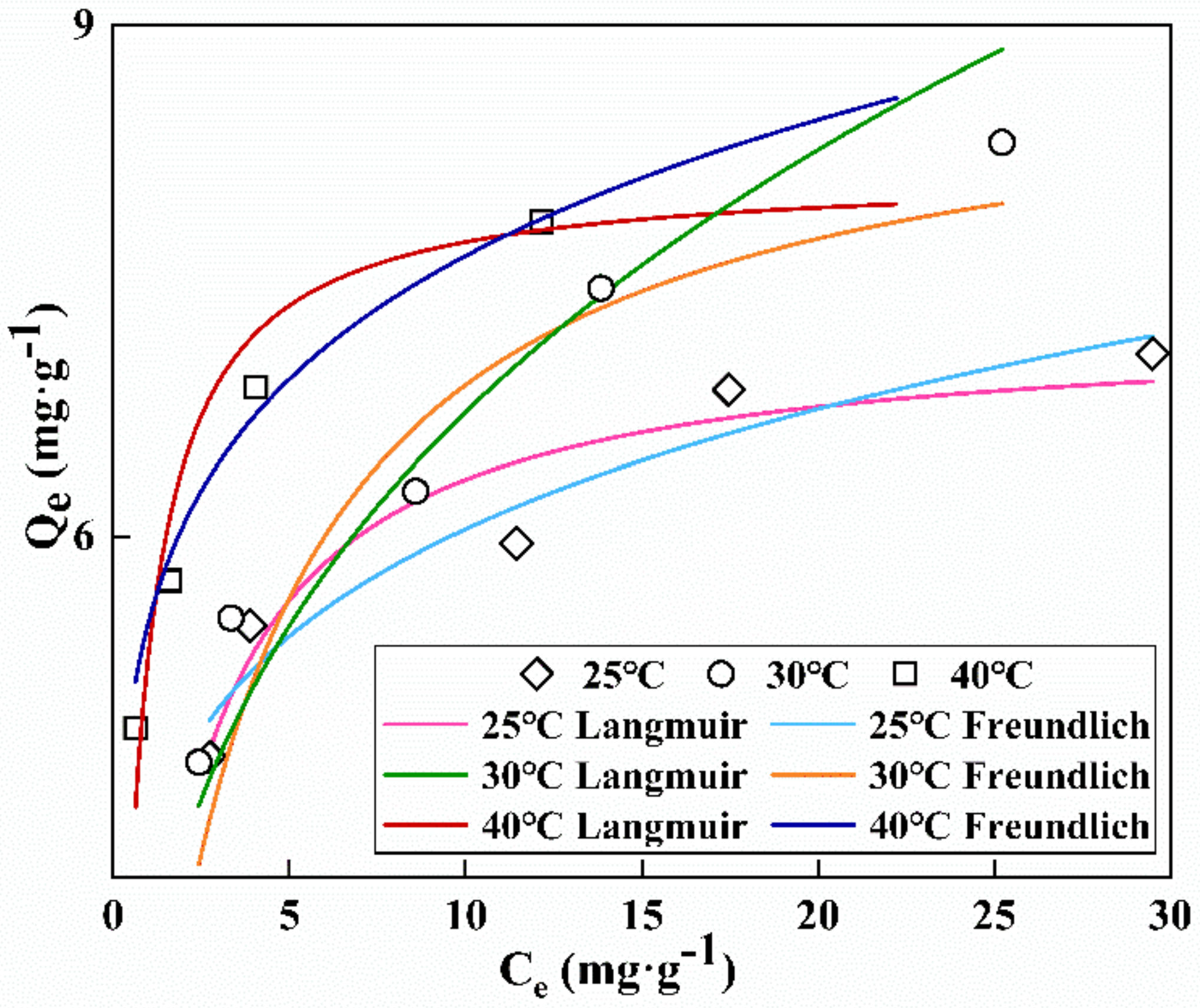
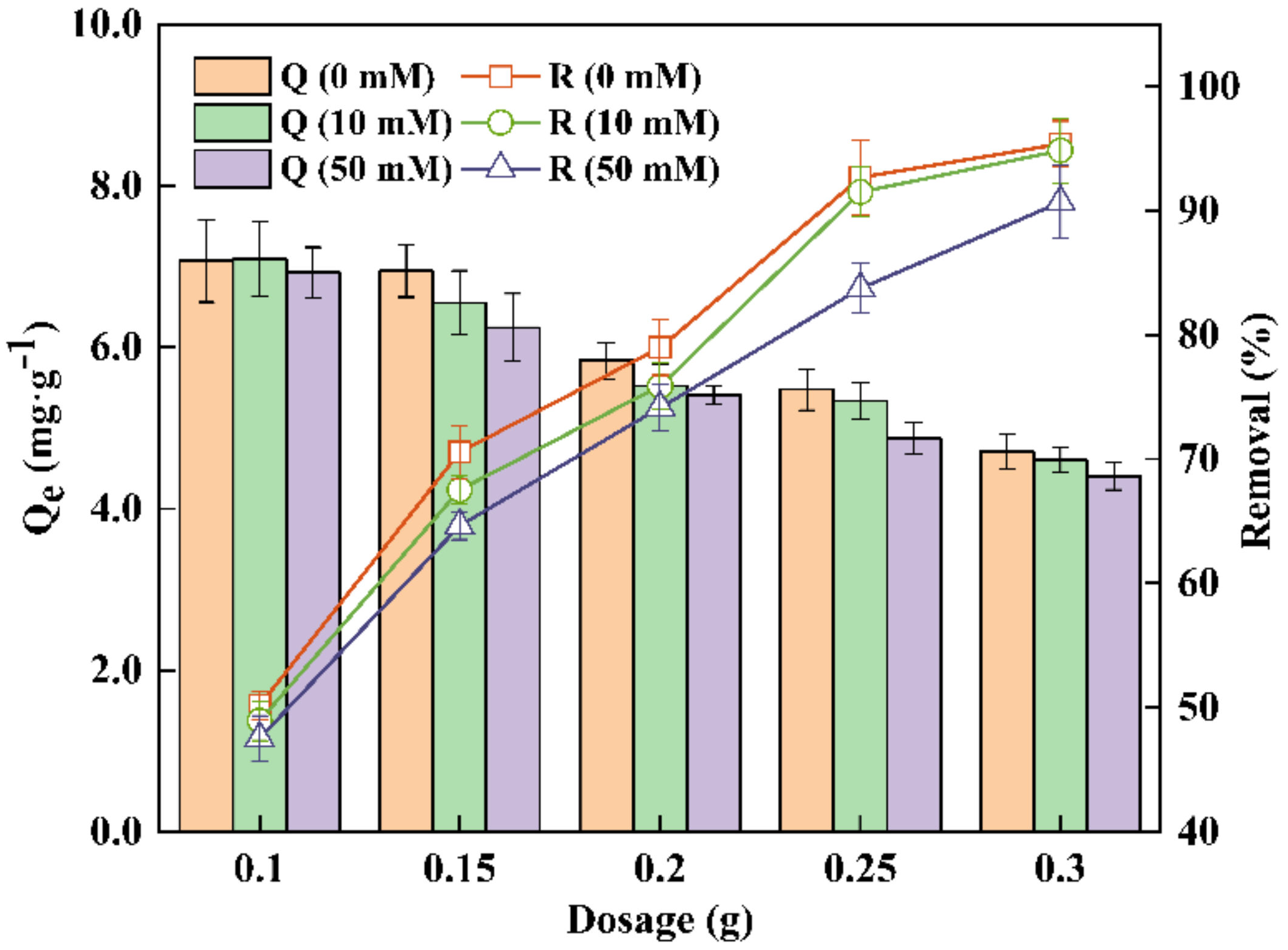
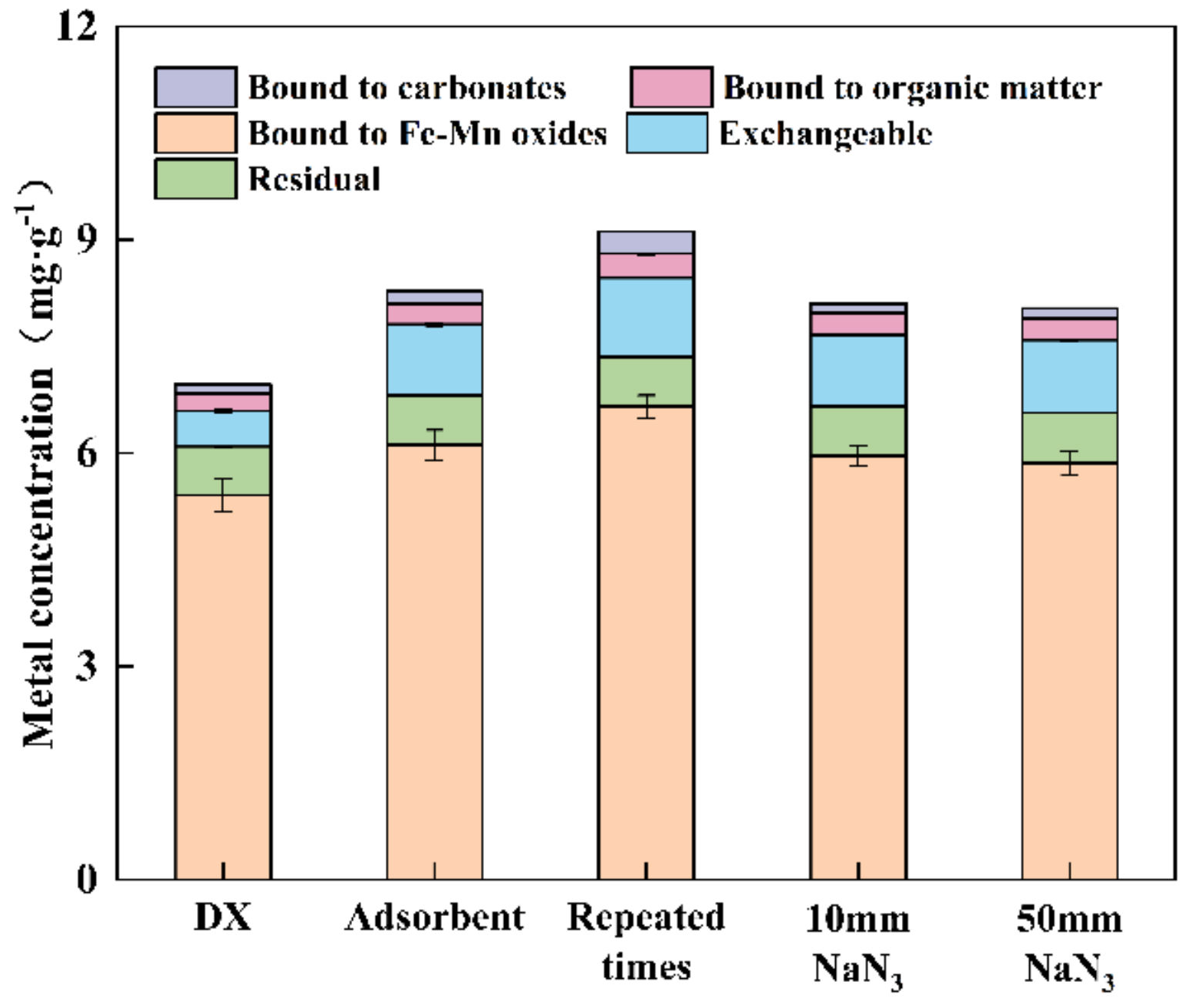
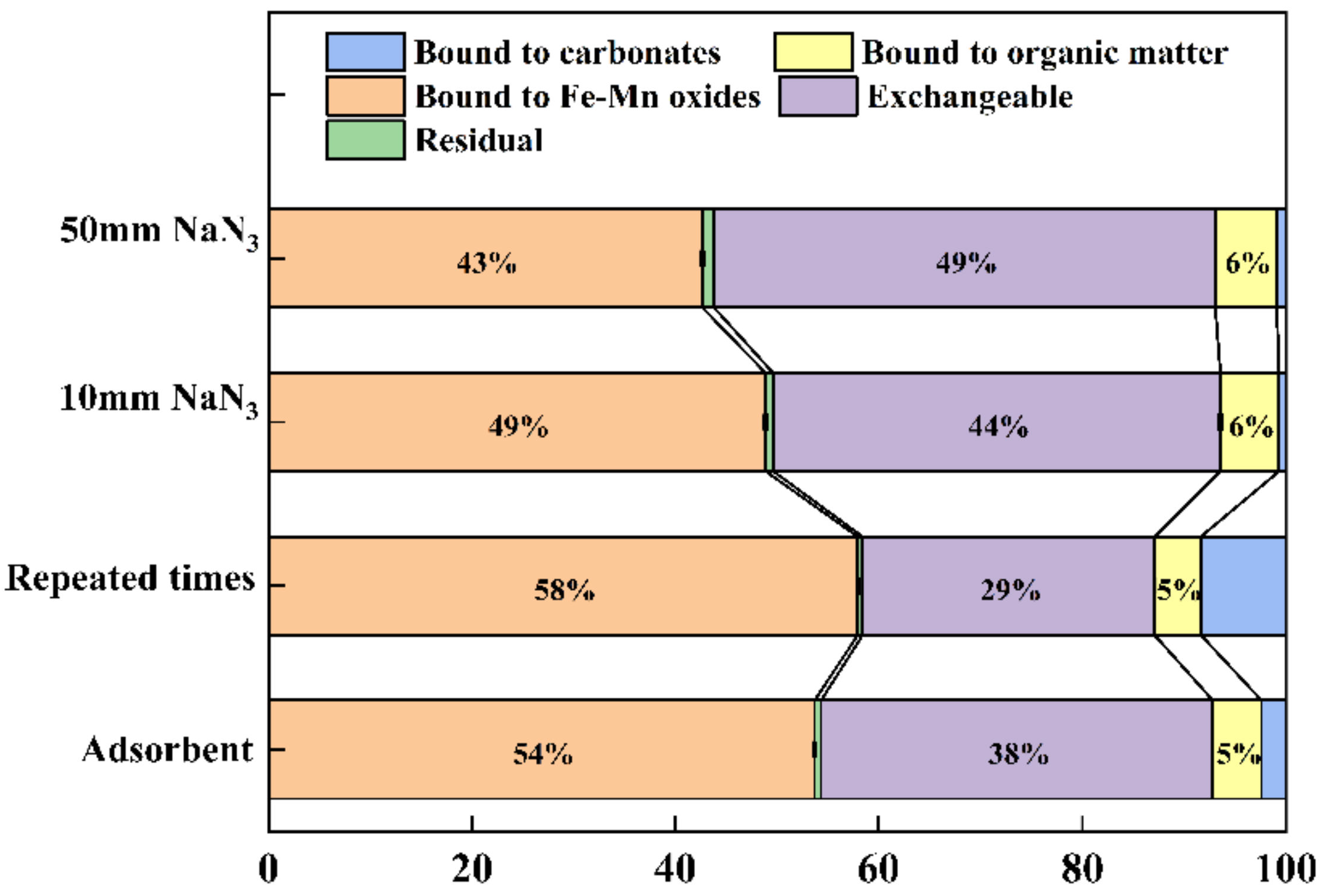
| Temperature (°C) | pH | DO (mg·L−1) | Conductivity (μs) | Turbidity (NTU) | NH4+ (mg·L−1) | TP (mg·L−1) | Mn(II) (mg·L−1) |
|---|---|---|---|---|---|---|---|
| 22.6 | 7.3 | 6.6 | 832 | 2.61 | 14.3 | 0.05 | 3.85 |
| Organic Matter (g/kg) | pH | CEC (cmol·kg−1) | Moisture Content (%) | SiO2 (%) | Al2O3 (%) | CaO (%) | MnO (%) | Fe2O3 (%) |
|---|---|---|---|---|---|---|---|---|
| 28.5 | 7.62 | 14.21 | 46.38 | 48.4 | 6.38 | 6.08 | 5.28 | 4.86 |
| Model | Parameter | R2 |
|---|---|---|
| Pseudo-first-order | k1 = 0.165 | 0.886 |
| Pseudo-second-order | k2 = 0.055 | 0.952 |
| Elovich | a = 162.099; b = 2.545 | 0.994 |
| Intraparticle diffusio | kd = 4.584; c = 0.055 | 0.570 |
| Temperature | Langmuir | Freundlich | ||||
|---|---|---|---|---|---|---|
| KL L·mg−1 | Qmax mg·g−1 | R2 | KF g·kg−1 | n | R2 | |
| 25 °C | 0.693 | 7.245 | 0.917 | 4.193 | 6.291 | 0.936 |
| 30 °C | 0.350 | 8.851 | 0.875 | 3.392 | 3.362 | 0.972 |
| 40 °C | 1.868 | 8.140 | 0.938 | 5.492 | 6.966 | 0.984 |
Publisher’s Note: MDPI stays neutral with regard to jurisdictional claims in published maps and institutional affiliations. |
© 2022 by the authors. Licensee MDPI, Basel, Switzerland. This article is an open access article distributed under the terms and conditions of the Creative Commons Attribution (CC BY) license (https://creativecommons.org/licenses/by/4.0/).
Share and Cite
Yang, F.; Tang, Y.; Mi, Y.; Jiang, L.; Luo, P.; Yang, Y. Mn(II) Sorption on Stream Sediments Sampled in Manganese Mining Area: Dynamics and Mechanisms. Appl. Sci. 2022, 12, 3368. https://doi.org/10.3390/app12073368
Yang F, Tang Y, Mi Y, Jiang L, Luo P, Yang Y. Mn(II) Sorption on Stream Sediments Sampled in Manganese Mining Area: Dynamics and Mechanisms. Applied Sciences. 2022; 12(7):3368. https://doi.org/10.3390/app12073368
Chicago/Turabian StyleYang, Fan, Yankui Tang, Yuwei Mi, Lu Jiang, Penghong Luo, and Yang Yang. 2022. "Mn(II) Sorption on Stream Sediments Sampled in Manganese Mining Area: Dynamics and Mechanisms" Applied Sciences 12, no. 7: 3368. https://doi.org/10.3390/app12073368
APA StyleYang, F., Tang, Y., Mi, Y., Jiang, L., Luo, P., & Yang, Y. (2022). Mn(II) Sorption on Stream Sediments Sampled in Manganese Mining Area: Dynamics and Mechanisms. Applied Sciences, 12(7), 3368. https://doi.org/10.3390/app12073368





